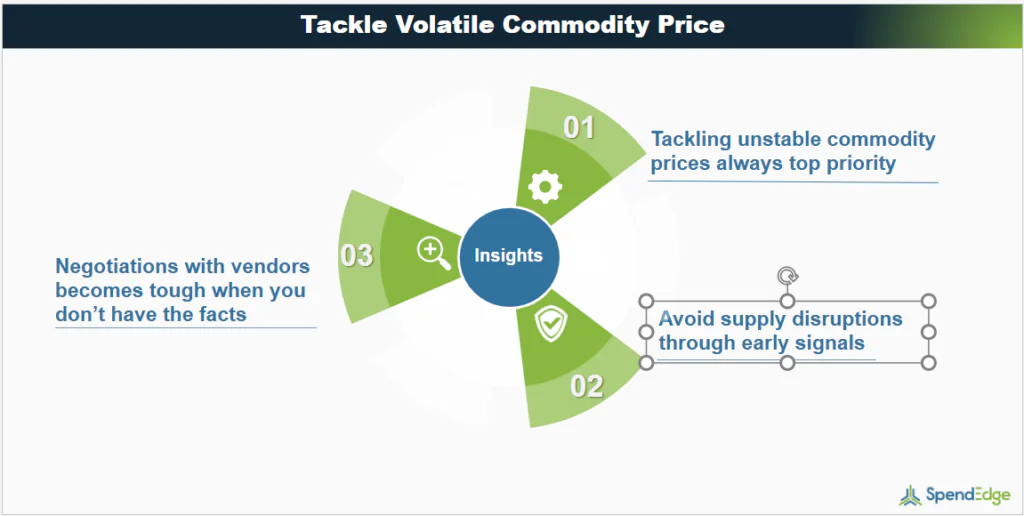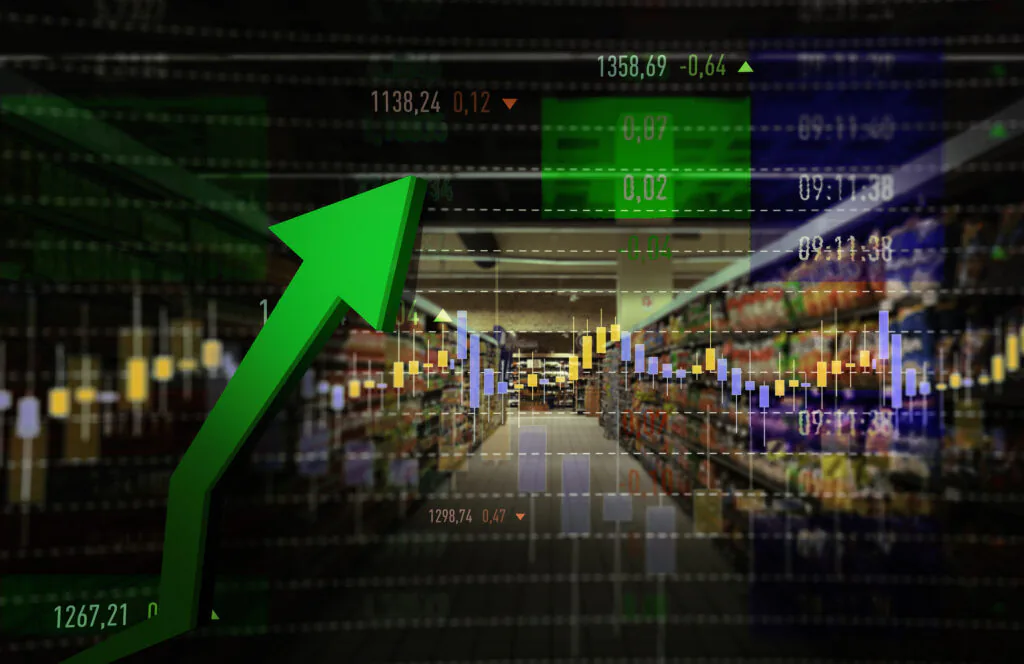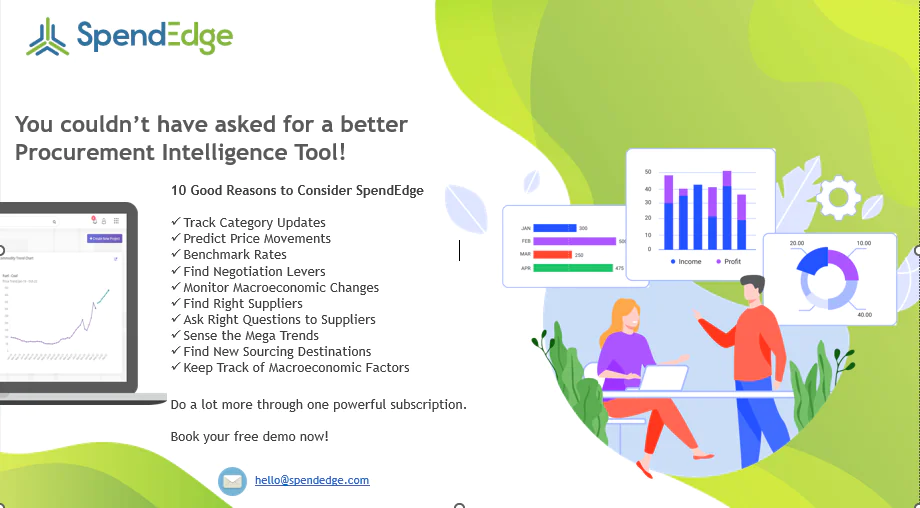Written by: Srinivas
Procurement organizations must think ahead of the curve!
Commodity prices are expected to show a slight decline in 2024, following a more significant drop of nearly 24% in 2023. The World Bank forecasts a 4% decrease in the commodity price index for 2024. Energy prices are predicted to fall by almost 5% during the same period, driven by lower natural gas and coal prices balancing out higher oil prices. While Brent crude oil prices briefly exceeded $91/bbl in early April 2024 due to rising geopolitical tensions and production cuts by OPEC+, the average price for the full year is anticipated to be $84/bbl. Despite remaining high in Europe, natural gas prices saw a 5% decrease in Q3 2023.
Agricultural prices have shown relative stability, with a modest 2% decline in Q3 2023 and a 3% drop compared to a year earlier. Food prices experienced more significant declines of 6% over the past year. The expectation of a strong supply is set to boost global corn production to a record level in 2023-2024, leading to a significant easing of prices.
Metal prices have weakened due to concerns about demand, with the World Bank anticipating the metal price index to remain steady in 2024 before an increase in 2025. However, copper prices surged to a two-year peak in April 2024 due to worries about supply and the resilience of global economic activity. It is projected that commodity market volatility will lessen in 2024 compared to the fluctuations seen in 2023 caused by the pandemic, the war in Ukraine, and conflicts in the Middle East. Despite this, geopolitical risks persist, with the potential for further escalation in the Middle East presenting a significant upside risk to prices.
Challenges of the Service

Tackling unstable commodity prices always top priority
The unpredictability of prices can hinder the precision of cost predictions and budget planning, potentially resulting in profit margin reduction if price hikes cannot be transferred to customers. This could have a greater impact in cases where the commodity is a critical commodity or it is purchased in high volumes. So, having a foresight into price movements of the commodities of the net 3-6 months is vital. This way commodities procurement teams can plan their purchases in advance and try to keep cost under control.
Negotiations with vendors becomes tough when you don’t have the facts
Not just for raw material or commodities purchase, it is important for procurement managers to have a visibility into impact of raw material price changes on finished products. Many times vendors request for contract price adjustments on basis on increase in commodity prices, labor rates, transportation cost etc., and it is always a puzzle for the category managers to validate these claims. In such cases, having access to historic, current and forecast prices of critical commodities comes in handy and allows category managers to conduct informed negotiations with the vendors.
Avoid supply disruptions through early signals
Increased price volatility raises the likelihood of supply chain challenges as suppliers face financial difficulties, leading to delays, quality issues, and potential supplier bankruptcy. This creates a significant risk for procurement teams as there could be delay in supplies, increased cost due to purchase from alternative suppliers, reduced customer satisfaction and much more. Gaining early signals on price of the commodity, supply-demand shifts, forecast of price movements can help procurement teams assess potential risks and plan for efficient mitigation strategies.
How SpendEdge can help you?
Gain accurate price forecasts to tackle commodity market volatility
SpendEdge Central platform provides accurate insights on critical commodities including fuel, metals, chemicals, packaging etc., to help category managers gain insights on current, forecasted and historic prices. Our in-house analytics teams build and maintain best-in-class models to provide accurate forecast for 6 months duration. We take into consideration over 2-3 years of historic prices along with macroeconomic factors to ensure high accuracy. Our domain experts and external experts also validate the forecasts and help us fine-tune the model on a regular basis.
Open new vistas for cost savings
Clients across industries are leveraging our commodities price tracking and forecasting tool to uncover new cost-saving opportunities across all critical commodities. Not just price levels and forecasts, our tool also provides with loads of qualitative insights that enable procurement teams to get insights on supply-demand shifts, cost drivers, macroeconomic shifts etc., to gain clarity on what affects commodity prices In addition, our category intelligence reports provide with insights on cost saving opportunities, negotiation levers, pricing models, TCO and much more ensuring a complete coverage of insights to support cost savings.
Ensure procurement risks show up on your radar
Our incisive procurement analysis enables client teams to develop the right backup plans to insulate the sourcing organization from various business risks. Our experts evaluate current and potential risks at a commodity level as well as per-supplier level, so clients can take timely action to plug supply-side vulnerabilities and always ensure a smooth flow of goods and services. Our risk management tools put timely alerts at the fingertips of commodity managers to help them improve the bounce-back capabilities of their supply networks.
Helping a North American Manufacturing Firm Avoid Risks Due to Price Volatility of Commodities

Our client is a mid-sized chemicals manufacturer in North America, and it has operations across the US, Mexico and few South American Countries. By mid-2022, well productivity has jumped by almost a quarter year on year. Impressive plant level outputs and surging demand for chemicals products have been driving strong margin growth for the client. With rigorous fiscal discipline, the client continues to generate positive cash flows from its income-generating assets while delivering respectable returns to investors. However, return on investment (RoI) is not the client’s sole consideration. The company is also resolved to minimize the environmental, social, and governance (ESG) footprint of its oil and gas infrastructure in line with the pathway to Net Zero envisioned by 2050.
With increase in production and expanding operations, the client also faced a need to increase purchase of raw materials and at the same time identify opportunity to save costs with higher volumes and avoid risks due to volatile prices. They had a set of approved vendors from whom they were purchasing small quantities. But they wanted to expand the scale now and were keen on identifying alternative sourcing destinations to achieve cost advantage. They turned to SpendEdge Central platform which allowed them to get insights into pricing landscape across all regions, allowing them to understand differences in price of a commodity between different sourcing destinations.
In addition, they were able to see accurate forecast of commodity prices for next 6 months and based on it plan their purchases. The tool not only provided pricing information, but also provided insights on critical qualitative insights such as supply-demand trends, cost drivers, supplier level news etc., that gave a better perspective of what affects commodity prices.
In addition to the traded commodities, they were keen on optimizing the purchase for a few finished products. SpendEdge was able to offer them with insights on price movements of finished products as well through assessment of volatile prices of underlying raw materials and other overheads. The client received quarterly newsletters with analysis and recommendations on price movements, factors affecting the price of finished products, supplier news, negotiation levers and much more. We were able to deliver a comprehensive solution tailored to the growing business needs of the client.





